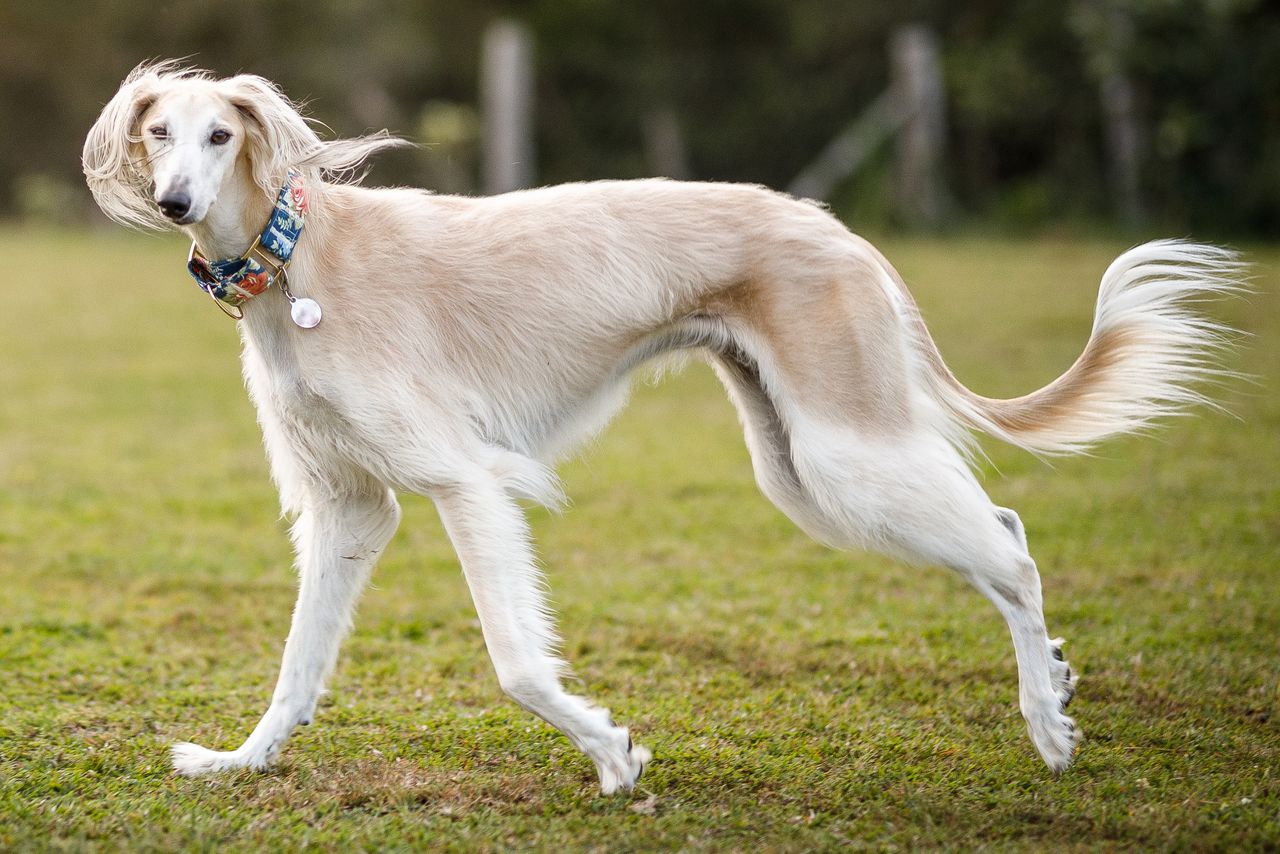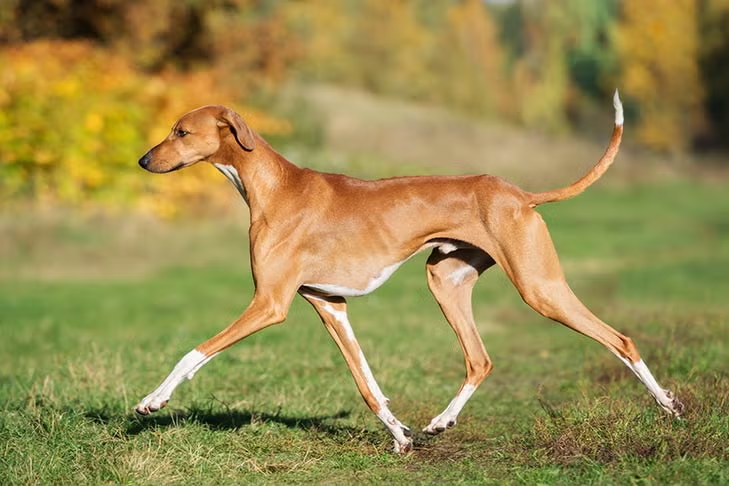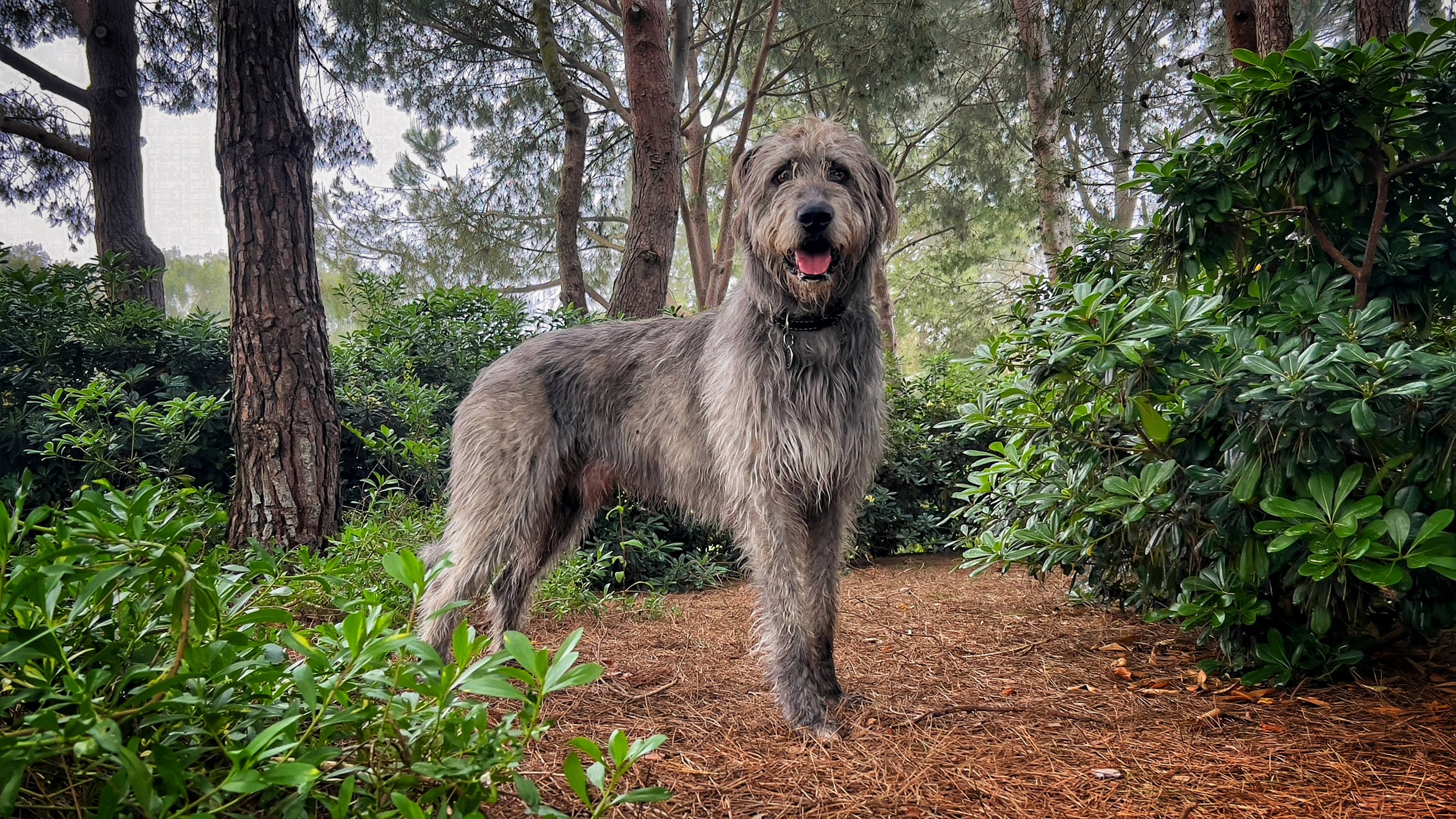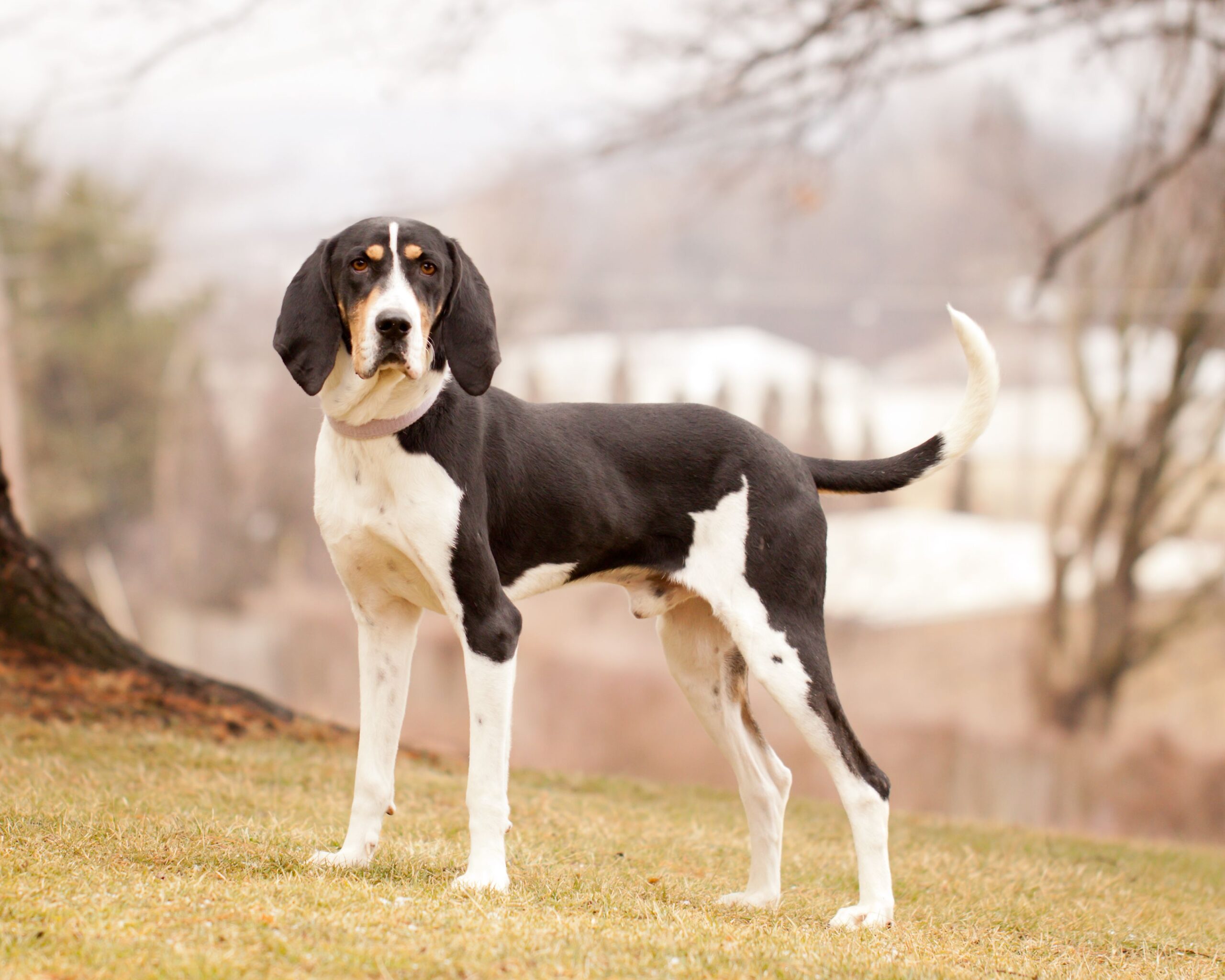My Unexpected Encounter with the Royal Dogs of Egypt
The first time I saw a Saluki in person was at a specialty dog show outside of Boston. I had wandered into the sighthound ring during my lunch break, and there it was – a creature that seemed to embody both strength and delicacy in perfect harmony. With its deep chest, impossibly narrow waist, and long, elegant limbs, this dog looked like it had stepped directly off an ancient Egyptian tomb painting and into the modern world. The most striking thing, though, was the dignified, almost regal way it carried itself – aloof yet aware, serene yet ready to explode into action at any moment. I was completely transfixed.
After the judging, I approached the owner, a woman who had been breeding Salukis for over thirty years. “They’re not like other dogs,” she told me with a knowing smile. “Once you live with a Saluki, you’ll never see dogs the same way again.” Over the next hour, she shared stories about the breed that had captivated desert nomads, pharaohs, and kings for thousands of years – and by the end of our conversation, I understood why Saluki enthusiasts speak of these dogs with something approaching reverence.
If you’ve never encountered a Saluki, or perhaps only seen them in pictures, you’re missing out on one of the most ancient, athletic, and aristocratic breeds in the canine world. With their distinctive appearance, incredible speed, and independent yet sensitive nature, Salukis are unlike any other dog – and they’re certainly not for everyone. But for those who appreciate their unique qualities, they offer a connection to the very origins of the human-canine partnership.
Whether you’re considering adding one of these desert hounds to your family, curious about their incredible history, or simply fascinated by distinctive dog breeds, I’ve put together the ultimate guide to Salukis. From their 5,000+ year history to what they’re actually like as companions (spoiler alert: they’re complex!), we’ll cover everything you need to know about these extraordinary dogs. So grab your favorite beverage, get comfortable, and let’s explore the wonderful world of Salukis!
Ancient Heritage: The 5,000-Year History of Salukis
To truly understand what makes Salukis so special, we need to appreciate their extraordinary history, which stretches back further than almost any other dog breed and has shaped every aspect of these remarkable animals.
The Royal Dogs of Antiquity
The Saluki is often cited as the world’s oldest known breed of domesticated dog, with a history that can be traced back at least 5,000 years. Archaeological evidence, including mummified remains and artistic depictions, confirms their presence alongside humans in ancient Mesopotamia (modern-day Iraq and parts of Syria) and Egypt.
In ancient Egypt, Salukis were so revered that they were often mummified upon death like members of the royal family. Hieroglyphics and tomb paintings depict these elegant hounds hunting alongside pharaohs, a privilege not granted to other types of dogs, which were often considered unclean. The breed’s association with royalty earned them the nickname “Royal Dog of Egypt,” and their elevated status meant they were often given as precious gifts to visiting dignitaries and kings.
The Saluki’s name likely derives from the ancient Sumerian city of Saluk or the Arabian city of Saluq. As trade routes expanded across the Middle East, North Africa, and Asia, Salukis traveled with caravans and nomadic tribes, adapting to diverse terrains while maintaining their core hunting abilities and distinctive appearance.
Desert Hunters and Bedouin Companions
For thousands of years, Salukis served as hunting partners to Bedouin tribes in the Middle East. Unlike many other dogs that were kept outside the camp or home, Salukis were often allowed inside Bedouin tents due to their cleanliness and valued status. The nomadic tribes depended on these swift hounds to catch game in the harsh desert environment, where food was scarce and every successful hunt was crucial for survival.
In Bedouin culture, Salukis were so highly prized that they were referred to as “el hor” (the noble ones) and were the only dogs allowed to ride on camels alongside their owners. They were considered gifts from Allah and were never sold but only given as gifts of honor or in tribute.
The breed was carefully maintained through selective breeding focused on hunting ability, speed, and endurance rather than standardized appearance. This practical approach to breeding – prioritizing function over form – helped preserve the Saluki’s remarkable athleticism and health over millennia.
Introduction to the Western World
Salukis remained relatively unknown in the Western world until the late 19th and early 20th centuries. British officers and diplomats stationed in the Middle East became fascinated with these ancient hunting hounds and began bringing them back to Europe.
The first Salukis arrived in England around 1840, but it wasn’t until after World War I that the breed gained significant recognition outside the Middle East. The Saluki Club of America was formed in 1927, and the American Kennel Club recognized the breed in 1929.
Throughout their transition to life as companions rather than primarily hunting dogs, Salukis have maintained the distinctive physical and temperamental characteristics that served them for millennia in the desert. Today’s Salukis remain remarkably similar to those depicted in ancient art, a testament to the breed’s successful adaptation and the dedicated preservation efforts of enthusiasts worldwide.
The Saluki Look: Desert-Adapted Elegance
Salukis possess a distinctive appearance that instantly sets them apart from other breeds. Their form perfectly follows their function as desert-adapted hunters, creating a silhouette that combines speed, efficiency, and a unique elegance.
Size, Build, and Overall Appearance
Salukis are medium to large sighthounds with a distinctly graceful and balanced appearance. Males typically stand 23-28 inches at the shoulder and weigh between 40-65 pounds, while females are slightly smaller at 23-26 inches and 35-55 pounds.
Their overall appearance conveys both speed and endurance, with a perfect balance of strength and refinement. Key physical features include:
- A long, narrow head with a distinctly “aristocratic” expression
- Large, oval eyes ranging in color from dark hazel to deep brown
- Long, mobile ears covered with silky hair (feathering)
- A deep but narrow chest that allows for maximum lung capacity
- An extremely tucked abdomen rising into a pronounced arch over the loin
- Long, lean, and muscular limbs built for efficient running
- Large, well-knuckled feet with thick pads that can withstand rough terrain
- A long, low-set tail carried in a natural curve
Perhaps most striking is the Saluki’s movement – a floating, seemingly effortless gait that covers ground with remarkable efficiency. At top speed, these dogs can reach up to 40-45 miles per hour, making them among the fastest of all dog breeds, second only to Greyhounds in flat-out speed but with greater endurance for longer chases.
Coat Varieties and Colors
Salukis come in two distinct coat varieties: smooth and feathered. Smooth Salukis have short, sleek hair over their entire body, while feathered Salukis have silky, flowing hair (feathering) on their ears, tail, the back of their legs, and sometimes between their toes.
Both varieties have soft, smooth body coats that serve an important purpose – allowing efficient cooling in the desert environment where they originated. Unlike many breeds with thick undercoats for insulation, Salukis evolved to release body heat easily, a crucial adaptation for hunting in high temperatures.
Salukis come in a wide range of colors, all of which are considered equally acceptable in the breed standard:
- White
- Cream
- Fawn (ranging from pale gold to rich red)
- Grizzle (a mixture of light and dark hairs)
- Tricolor (usually black and tan with white markings)
- Black and tan
- Red
- Golden
Many Salukis have white markings on the feet, chest, and tip of the tail, and some have facial markings like blazes or masks. The diversity of colors reflects the breed’s ancient heritage and development across a vast geographical range, where different color variants may have been preferred in different regions.
Despite their elegant appearance, Salukis’ coats are remarkably low-maintenance. Weekly brushing is typically sufficient for smooth varieties, while feathered Salukis may need slightly more attention to prevent tangles in their longer hair. They’re known for being naturally clean with minimal “dog odor,” a trait that likely contributed to their acceptance inside nomadic tents and royal quarters throughout history.
Personality & Temperament: The Saluki Soul
Perhaps no aspect of Salukis is more misunderstood than their personality. Often described as “aloof” or “cat-like,” there’s much more nuance to the Saluki temperament than these simple characterizations suggest.
The Independent, Thoughtful Nature
The most defining characteristic of Saluki temperament is their independence. Unlike many breeds bred for constant interaction with humans (like retrievers or herding dogs), Salukis were developed to make quick decisions while hunting at a distance from their human partners. This created a dog that thinks for itself rather than constantly looking to humans for direction.
This independence doesn’t mean Salukis don’t form deep bonds with their people – quite the contrary. Most Salukis become deeply attached to their owners and can suffer from separation anxiety if left alone too much. However, they express this attachment differently than more demonstrative breeds. A Saluki’s devotion often manifests as a quiet presence, choosing to be in the same room as their people rather than demanding constant attention or interaction.
Salukis are thoughtful dogs who seem to consider situations before reacting. They observe their environment carefully and process information at their own pace. This thoughtfulness can sometimes be mistaken for aloofness or disinterest, but experienced Saluki owners recognize it as the contemplative nature that served these dogs well as hunters for millennia.
Sensitivity and Reserve
Another key aspect of Saluki temperament is their remarkable sensitivity. These dogs are finely attuned to their environments and particularly to the emotions of their human family members. Harsh words or conflict can deeply affect a Saluki, and they typically respond poorly to forceful training methods or any form of roughness.
This sensitivity extends to their interactions with strangers. Most Salukis are naturally reserved with people they don’t know – not fearful or aggressive, but simply cautious and dignified. They typically won’t rush to greet visitors with exuberance but will instead hang back and assess the situation before deciding whether to approach. Once a Saluki accepts someone, however, that person is welcomed into their circle of trust.
With family members, especially those who understand and respect their nature, Salukis often show a playful, sometimes silly side that visitors rarely see. This private playfulness, revealed only to those they trust completely, is one of the special joys of living with the breed.
The Hunter’s Heart
Despite thousands of years of domestication and their often calm demeanor at home, Salukis remain hunters at heart. Their prey drive – the instinct to spot, chase, and capture moving animals – is among the strongest of any breed and has profound implications for living with them as companions.
A Saluki who spots a rabbit, squirrel, or even a plastic bag blowing in the wind may instantly transform from a serene couch ornament to a focused predator. Their exceptional eyesight can detect minute movements at great distances, and once they lock onto potential “prey,” their recall reliability drops dramatically as hunting instincts take over.
This prey drive means that Salukis should never be trusted off-leash in unsecured areas, regardless of how well-trained they seem. A securely fenced yard (minimum 6 feet high) is essential for allowing them safe freedom to run, and leashed walks should be conducted with awareness of their potential to lunge after small animals.
The flip side of this strong prey drive is the Saluki’s natural athleticism and joy in running. Providing safe outlets for this instinct – through lure coursing, straight racing, or running in securely fenced areas – is one of the greatest gifts an owner can give their Saluki.
Living With a Saluki: Practical Considerations
Beyond their history and personality, what’s it actually like to share your home with a Saluki? There are some unique considerations that potential owners should understand before bringing one of these special dogs home.
Exercise and Space Needs
Despite their athletic capabilities, Salukis don’t require constant exercise. They typically follow a pattern of short bursts of intense activity followed by long periods of rest – a natural energy conservation strategy developed for desert hunting. Most Salukis are content with a couple of walks daily plus occasional opportunities (ideally 2-3 times weekly) to run full-out in a safely enclosed area.
That said, regular exercise is essential for their physical and mental well-being. A Saluki who never gets to run is like a fish that never gets to swim – you’re denying them the expression of their most natural behavior. Options for safe running include:
- A large, securely fenced private yard (fences should be at least 6 feet high with no gaps)
- Enclosed dog parks during quiet hours (when there are fewer dogs to avoid overwhelming sensitive Salukis)
- Organized lure coursing or straight racing events for sighthounds
- Long-line exercise in open, safe areas (using a 30-50 foot training lead)
Contrary to what some might expect, many Salukis adapt well to apartment living provided their exercise needs are met. Inside the home, they’re typically calm, quiet, and take up surprisingly little space for their size, often curling into tight balls when sleeping. Their natural cleanliness and minimal barking make them good neighbors.
Climate Considerations
Salukis’ desert heritage has created a breed with specific climate adaptations. Their thin coats and minimal body fat mean they’re highly sensitive to cold and require protection in chilly weather. Most Salukis need sweaters or coats for winter walks, and many appreciate warm bedding year-round.
Conversely, most Salukis handle heat quite well compared to many breeds, though common sense precautions like access to shade and fresh water are always important. Their natural cooling mechanism – releasing heat through their thin skin rather than primarily through panting – makes them more efficient in hot weather than many heavily-coated breeds.
Training and Socialization
Training a Saluki requires understanding their unique mindset and using approaches that work with, rather than against, their natural tendencies. Effective Saluki training typically involves:
- Positive reinforcement using rewards the individual dog values (which might be treats, play, or simply praise)
- Consistency and clear communication about expectations
- Short, engaging sessions that prevent boredom
- Respect for their sensitive nature and thoughtful approach to learning
- Recognition that certain instinctive behaviors (like chasing) can be managed but rarely eliminated
Early socialization is crucial for Salukis to develop confidence and appropriate responses to new situations. Introducing puppies to a wide variety of people, animals, environments, and experiences helps prevent the shyness that can develop in poorly socialized individuals.
While most Salukis can learn basic obedience and house manners, they’re not typically motivated by the desire to please that drives many more biddable breeds. Instead, they tend to evaluate commands with an attitude of “What’s in it for me?” or “Does this make sense?” Training that addresses these questions – by offering worthwhile rewards and logical commands – tends to be most successful.
Health Considerations
Salukis are generally healthy dogs with a typical lifespan of 12-14 years, impressive for a breed of their size. As one of the oldest breeds with minimal interference in their development, they’ve avoided many of the genetic health problems that plague some more recently developed breeds.
However, there are some health considerations specific to Salukis:
- Sensitivity to anesthesia and certain medications: Like other sighthounds, Salukis metabolize drugs differently due to their low body fat percentage and unique liver function. Always ensure your veterinarian has experience with sighthounds or is willing to research appropriate protocols.
- Cardiac issues: Certain heart conditions, including various forms of cardiomyopathy, can occur in the breed.
- Hemangiosarcoma: This cancer of the blood vessels appears with some frequency in the breed.
- Autoimmune disorders: Various autoimmune conditions occasionally appear in Salukis.
Responsible breeders screen for genetic health issues and work to produce sound, healthy puppies. When considering a Saluki puppy, asking about health testing and the longevity of related dogs provides insight into what to expect.
Due to their thin skin and minimal padding, Salukis can be prone to cuts, scrapes, and pressure sores if they don’t have access to soft resting surfaces. Many owners provide multiple cushioned beds around the home to prevent these issues.
Salukis and Other Pets: Managing the Hunter’s Instinct
One of the most important considerations for potential Saluki owners is how these dogs interact with other animals. Their strong prey drive significantly impacts their ability to peacefully coexist with smaller pets.
Salukis and Cats
The relationship between Salukis and cats is highly individual and depends on several factors. Some Salukis live harmoniously with cats, particularly when:
- They’re raised with cats from puppyhood
- The cats are confident and not prone to running when the dog is present
- The individual Saluki has a relatively low prey drive
- Interactions are carefully managed, especially during early introductions
However, many Salukis maintain a strong chase instinct even toward cats they’ve lived with for years. This doesn’t mean they intend to harm the cat – the chase itself is what drives them – but the size difference creates obvious risk. Households with both Salukis and cats typically need management strategies like:
- Separate spaces where cats can retreat beyond the dog’s reach
- Supervision during interactions, especially when the dog is excited
- Training the Saluki to respond to interruption cues when focusing on the cat
- Never leaving them alone together if there’s any history of chasing behavior
Some Saluki rescues “cat-test” their dogs to identify those who show minimal interest in chasing cats, making it easier to match dogs with appropriate homes.
Salukis and Small Animals
With smaller pets like rabbits, guinea pigs, hamsters, and birds, the situation is generally more clear-cut. These animals closely resemble the natural prey that Salukis were bred to hunt for thousands of years, and their movements are particularly likely to trigger chase responses.
While there are always exceptions, most experienced Saluki owners recommend complete separation between Salukis and small prey animals. This typically means keeping small pets in secure rooms or enclosures and never leaving the dog unsupervised in their presence.
Outdoor wildlife presents another consideration. Many Salukis will enthusiastically chase squirrels, rabbits, and other wild animals they encounter on walks or in yards. Secure leash handling and properly contained areas for off-leash time are essential for both the dog’s safety and wildlife protection.
Salukis and Other Dogs
Most Salukis get along well with other dogs, particularly when properly socialized. Their ancient pack-hunting background typically gives them good canine social skills and appropriate communication with other dogs.
Many Saluki owners find that having two or more sighthounds provides ideal companionship, as they match each other’s play style and energy patterns. Salukis often enjoy playing with other sighthounds through “coursing games” – running together in playful pursuit patterns that satisfy their natural instincts in a controlled way.
When introducing a Saluki to other dogs, the same principles of good dog introductions apply: neutral territory, controlled circumstances, and awareness of each dog’s body language and comfort level. Most Salukis are not dog-aggressive, though like any breed, individual temperaments vary.
Is a Saluki Right for You? Honest Assessment
After learning all about these ancient, elegant hounds, you might be wondering if a Saluki would fit well in your lifestyle. Let’s take an honest look at who should (and perhaps shouldn’t) consider this breed.
You Might Be a Great Saluki Owner If…
A Saluki might be right for you if:
- You appreciate independent dogs with subtle, thoughtful personalities
- You have a securely fenced yard or reliable access to safe running areas
- You’re committed to keeping your dog on leash in unfenced areas regardless of training
- You understand and respect their hunting heritage and natural instincts
- You prefer a generally quiet, clean dog with moderate exercise needs
- You appreciate a sensitive dog that forms deep bonds with family
- You’re willing to use positive, gentle training methods
- You have experience with dogs or are willing to learn about sighthound-specific needs
- You’re prepared to provide protection from cold weather
Salukis can adapt well to various household compositions, including families with older children who understand how to interact respectfully with a sensitive dog. They often do well in quiet homes where their dignified nature is appreciated.
A Different Breed Might Be Better If…
A Saluki might not be the best choice if:
- You want a dog that’s easily trainable with high reliability off-leash
- You prefer dogs that are demonstratively affectionate with everyone they meet
- You have small pets and aren’t willing or able to manage potential prey drive
- You have very young children who might play roughly or unpredictably
- You want a guard dog (most Salukis are reserved but not protective)
- You need a dog that responds reliably to commands in all circumstances
- You live in an extremely cold climate without means to keep the dog warm
- You’re a first-time dog owner looking for an “easy” breed (Salukis require understanding of their unique needs)
Finding Your Saluki
If you decide a Saluki is right for you, there are several paths to finding your perfect companion:
- Breed-specific rescue organizations: Groups like the Saluki Club of America Rescue or regional sighthound rescues occasionally have Salukis in need of homes. Rescue dogs often come with the advantage of known personalities and established house manners.
- Reputable breeders: Research is essential to find breeders who prioritize health and temperament, conduct appropriate health testing, and provide lifetime support to puppy buyers. Expect a thorough interview process – good breeders care deeply about where their puppies go.
- Imports: Some serious Saluki enthusiasts import dogs from countries of origin like Saudi Arabia, Bahrain, or other Middle Eastern regions. These “desert bred” Salukis may differ somewhat from Western show lines.
Be prepared for a potential wait, especially if you’re seeking a puppy from a reputable breeder. The best breeders often have waiting lists and breed only when they have homes lined up for all puppies.
Conclusion: The Timeless Appeal of the Desert Hound
There’s something truly extraordinary about sharing your life with a breed that has remained largely unchanged for thousands of years. Looking into a Saluki’s eyes, one can’t help but feel connected to the ancient civilizations that first recognized the value of these remarkable hunting companions.
Living with a Saluki means embracing certain paradoxes – a dog of incredible speed who spends most of the day in elegant repose; an independent thinker who forms deep bonds with their chosen people; an ancient breed perfectly adapted to modern life as a companion. These contradictions create a multi-layered personality that reveals new depths over years of partnership.
Salukis aren’t for everyone, and that’s perfectly okay. Their unique combination of independence, sensitivity, and strong hunting instincts requires understanding and accommodation. But for those who appreciate their special qualities, Salukis offer a connection to history, a breathtaking demonstration of canine athleticism, and a subtle, dignified companionship unlike any other breed.
If you decide to welcome one of these ancient desert hounds into your heart and home, prepare for a relationship unlike any other – one filled with moments of both awe at their athletic grace and appreciation for their quiet, thoughtful companionship. As my Saluki mentor said years ago, “They’re not like other dogs” – and for the right person, that’s exactly what makes them so extraordinary.




